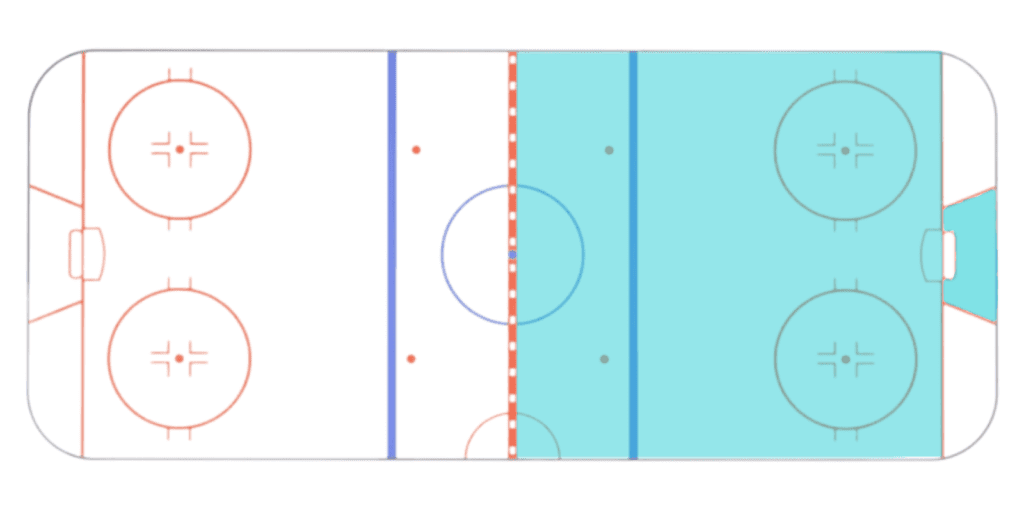Goalies are a different breed.
Whether it’s hockey, soccer, or lacrosse, goaltenders and goalkeepers have to have tough skin and maintain a healthy mindset to compete.
But… some things they do just seem strange. For instance… Why exactly do goalies leave their goal in hockey?
Is it to grab a hot dog or make an emergency run to the bathroom? Or… is there a strategic advantage to leaving their net?
In this article, we’ll show exactly why hockey goalies leave their net and why it’s important to the game.
Let’s begin.
Here’s Why Goalies Leave Their Net in Hockey:
In hockey, you’re allowed 6 players on the ice at any time (5 players and 1 goalie). When a team is down a goal in the last minutes of the game, coaches will “pull the goalie” in exchange for an extra player in a last-ditch effort to score.

Is the Goalkeeper Allowed to Leave the Goal in Hockey?
Yes, a goalie is allowed to leave their goal in hockey.
There are a variety of reasons they could leave the net.
For instance:
- To play the puck before the opposing team does
- To leave for an extra attacker in the last few minutes in order to tie the game
- To leave for an extra attacker during a delayed penalty
- To head to the bench in case they have an injury
- To head to the bench in case they have an equipment malfunction
- To head to the bench to switch places with the backup goalie
While there are a number of reasons a goalie may leave their goal, the most common reasons are because of a delayed penalty and if they’re losing with a few minutes left in the game.
Why Does the Goalie Leave in Hockey?
For the majority of the game, goalies will be hunkered down at their net.
However, usually once or twice a game, they’ll skate away from their net and head for the bench.
So, why do goalies leave in hockey?
There are two main reasons:
1. To Tie The Game With 2 Minutes Left
The primary reason you’ll see goalies leaving their net is when their team is trying to tie the game.
As mentioned above, a popular strategy in ice hockey is to trade your goalie for a player if you’re trailing late in the game.
Hockey rules state that each team can have 6 skaters on the ice at any one time. For most of the game, that means utilizing 5 players and 1 goalie.
However, when a team is down a goal or two with just a few minutes left in the game, coaches can pull their goalie in order to send in an “extra attacker”.
The offensive player will come out and take the goalies place as 6th skater on the ice. They’ll join the other 5 players in order to generate an offensive opportunity to tie the game.
The main theory is that if you’re going to lose by a goal, it’s worth losing by two goals in order to increase the odds that you can tie the game and potentially win.
This is a risky strategy… However, the risk tends to pay off pretty frequently.
In fact, NHL data between 2014 and 2020 shows that teams will score during about 15% of “pulled goalie” situations.
But… in 85% of situations, it doesn’t work. In fact, it often ends with the opposing team scoring another goal to extend their lead.
In some crazy scenarios, teams will have to make a diving effort in order to stop a team from scoring on their empty net:
2. To Score a Goal During a Delayed Penalty
There’s one other instance every game where you’ll see at least one team pull their goalie: during a delayed penalty.
When a penalty is called on a player, the officials won’t always stop the play immediately. For instance, if the player who committed the offense doesn’t have the puck, nor any of his teammates, and the team who is about to go on a power play still has the puck… the play will continue.
Referees won’t blow the whistle when the team who had the offense committed on them still is in possession of the puck. It wouldn’t be fair to them.
So, referees will allow them to continue playing as long as they have the puck. As soon as the team who committed the offense touches the puck, the referee will blow the whistle to stop the play.
This means that there isn’t a chance for the offending team to take a shot on the other team’s net… which means there’s an opportunity to pull the goalie in exchange for an extra attacker.
And… Like the first example above, there are instances when pulling the goalie during a delayed penalty doesn’t pay off. In some instances, it has led to an own-goal on their empty net:
These goals typically happened because a player on their own team happened to pass the puck backward and landed in their own net. And… this does count as a legal goal for the other team. Definitely not the best outcome for a delayed penalty (unless you’re the other team)!
There have even been instances when a pulled-goalie during a delayed penalty resulted in an official goal by a goalie!
When Can a Hockey Team Pull Their Goalie?
Hockey teams have a variety of reasons why they can pull their goalie in ice hockey.
For the majority of the game, goalies typically stay in their net.
However, the two main reasons they may leave the net are:
- To get an extra attacker during a delayed penalty, or
- To get an extra attacker if they’re losing near the end of the game.
Goalies may also leave the goal for a few other reasons:
- if they’re switching with the backup goalie
- if they have an equipment malfunction, or
- if they have an injury.
While goalies can leave the net at any time, the most advantageous times are when there’s a delayed penalty, or if they’re down by a goal with two minutes left.
Why Is There No Goalie in Ice Hockey?
Have you ever been watching a game of ice hockey… and you notice that there’s no goalie?
Well, that’s because they’ve left the net to go to the bench. Goalies will “trade places” with an offensive player during a delayed penalty, or if their team is down a goal with two minutes left in the game.
Goalies will leave so an extra attacker can come on to create an offensive opportunity and hopefully score a goal.
Can a Hockey Team Play Without a Goalkeeper?
Technically, yes.
Any hockey team can choose to play without a goalkeeper.
Goalies don’t actually have to be on the ice. The rules of hockey state that each team can have 6 skaters on the ice at a time.
Most teams will put 5 players out and 1 goalie as their 6 skaters.
However, teams will never be able to win if they deploy 6 skaters and no goalie out for an entire game.
They’ll only trade out their goalie for an offensive player during a delayed penalty or if they’re losing with a few minutes left to give a chance to tie the game.
Who Invented Pulling the Goalie?
The invention of the “pulled goalie” first came on the scene back in the early 1940s.
Frank Boucher was the first NHL coach to pull his goalie during an NHL game. In 1940, Boucher was the head coach of the New York Rangers–one of the “Original Six” teams.
Coach Boucher began pulling the goalie if his team was behind at the end of the game to generate a scoring opportunity. And, it began paying off, so every other team began adopting the strategy.
Did you know… Frank Boucher was also the innovator who came up with the idea of using two main goalies throughout the regular season. Nowadays, every team has a “starter” goalie and a “backup” goalie who they’ll rotate between throughout the year.
How Far Can a Goalie Come Out in Hockey?
Goalies are allowed to leave their net. But, there are limits.
If they’re “getting pulled”, they can head straight to their bench in exchange for an extra attacker.
But, if they’re going to play the puck, they can’t go everywhere. They’re limited to skating their half of the ice. This means they can’t pace the center red line.

They also can’t play the puck in the corners (outside the trapezoid behind their net). They can skate through this area, but if they touch the puck behind their goal line and outside the trapezoid, a penalty will be called against them.
The NHL implemented the trapezoid after the 2004-05 lockout as a way to protect goalies from injuries.
Can a Pulled Goalie Come Back in?
Once a goalie is pulled, can they come back in?
The short answer is yes!
Goalies are allowed to leave their net and head to the bench to switch places with a player.
However, they are allowed to skate back to their net at any time. They just need to make sure that a skater comes off the ice if they’re to do this, otherwise, it will result in a “too-many-men” penalty.
Is Pulling the Goalie Worth It?
So, is pulling the goalie worth it in ice hockey?
Well, after the 1940 season when Frank Boucher started pulling the goalie, every other team began doing it. So, if other NHL coaches have been doing it for 80+ years, I’d say it’s worth it.
As mentioned above, this strategy worked for NHL teams 15% of the time, on average, between 2014 and 2020.
However, it’s a risk. Here’s what The Boston Globe has to say about the risks of pulling the goalie:
“…mathematical studies indicate that the extra-man gambit works often enough to justify it. Andrew Thomas, who studied data from four NHL seasons during the past decade for an article in the Journal of Quantitative Analysis, found that 30 percent of the goals scored with the cage empty were tallied by the attacking side.”
If teams are going to be successful, they need to take their chances and pull the goalie if they’re down by a goal with a few minutes left. They have better odds of tying and possibly winning the game if they pull their goalie then if they don’t.
Do Teams Pull the Goalie When Down 3?
So, we know that teams will pull their goalie when they’re down by one goal and even two goals. But… What about three?
Do teams really pulled the goalie when down 3 goals?
Yes. Many teams will pull their goalie even if they’re losing by three goals. In fact, the more goals you’re losing by, the earlier you should pull your goalie according to hockey statistics.
Want more answers to the most common hockey questions? Be sure to check out our other popular articles: Hockey & Expired Helmets (16 Answers to Know), Who Is the Best Hockey Player in 2022? (Top 10 Ranked), and What Are the Top 10 Ice Hockey Countries?
Sources
https://hockey-graphs.com/2020/05/18/the-state-of-goalie-pulling-in-the-nhl/
